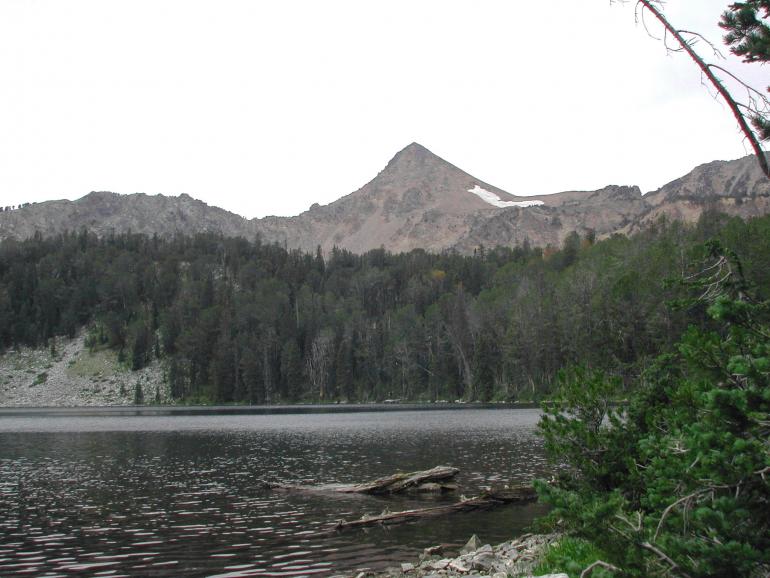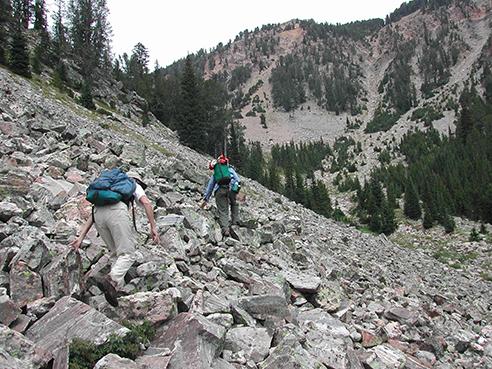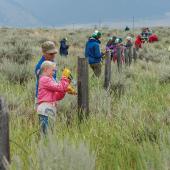Worth the Effort
Fishing Ramona Lake.
We almost turned around when we saw the fresh pile of bear scat in the clearing, as we emerged from thick underbrush along a tiny, unnamed creek. For the last half hour we had painfully bushwhacked our way through an almost impenetrable tangle of scrub, between embankments 20-30 feet high and topped by difficult and steep terrain on either side. We were grateful to reach an open area where we could stop and rest. I saw it first but before I could say anything, the others saw it too. It wasn’t steaming or anything, but was obviously deposited there within the last hour or so.
I was hiking with my friend John, who worked at the fish hatchery in Ennis, and two summer volunteers who worked with him: Eloise, a high-school biology teacher in her mid-40s, and Bill, a 19-year-old college student majoring in fisheries biology. John and I had hiked and fished together many times in the little creeks and high-alpine lakes of Madison and Gallatin counties. Bill was an experienced hiker and fly fisher, but Eloise was from Indiana and though she was physically fit, she had never spent time in the mountains. Like many anglers, John and I were always looking for new places to fish that offered solitude, and hopefully fish that perhaps had never seen an artificial fly. During the winter, while poring over my topographical map of the Lee Metcalf Wildness, I came upon Ramona Lake. When I arrived in Montana in the spring, I told John about it and showed it to him on the map. He took one look and said, “Let’s go.”
I did a little research on the FWP website. I learned that Ramona is small—only nine acres with a half-mile of shoreline—and is stocked periodically with westslope cutthroat, presumably by helicopter. Between the FWP site and my map, I determined there was no trail leading anywhere near Ramona, meaning that it’s accessible only on foot and only with a great deal of difficulty. John and I were excited, as this meant that not only could we count on solitude and naïve fish, but we would not hear the putt-putt of ATVs or encounter an outfitter’s pack string of horses with a dozen “dudes” on a pampered "adventure."
Ramona is located at an altitude of 9,191 feet, roughly the same as Avalanche and Blue Danube, two nearby lakes which I had fished before. Both of those lakes are nearly six miles from the trailhead, while Ramona is only about three-and-a-half, which told us that the going would be very steep and difficult.
When we met at the trailhead, I was expecting only John, and was surprised to see the other two. As I shook hands with John I asked him, “Do you think they are up to this? I’m expecting a hard hike up rough, steep terrain.”
He shrugged and said, “They say they are. They both asked if they could go with me and I didn’t feel like I could say no.” I was relieved to see that at least they both were carrying bear spray.
Then I saw Bill dragging an inflated float tube out of the back of John’s truck. I cornered John again. “He’s not going to try to drag that thing up there, is he?”
John shrugged again. “He wants to have it at the lake, and says he can do it.”
I shook my head and said, “We’ll see in a little while, won’t we?” I had never tried this hike before but I had seen the drainage where you have to leave the trail and bushwhack. I felt pretty sure he would never make it up there with the float tube.
We hiked two miles along the trail that runs along the West Fork of Beaver Creek to the third drainage with a tiny creek that crosses the trail, where we turned north. When we found the bear scat we all were out of breath from fighting our way through the underbrush and we stopped and stared for a few seconds. Then John asked, “Everybody okay?”
“Sure,” Bill and Eloise said at once as they reflexively placed their hands on their spray. John and I could see that they were nervous. “You want to turn back?” he asked.
“No, we’re fine,” Bill said. “Besides, we know the bear’s around here, but hell, it could be between here and the trail for all we know. We could have walked right by it. I haven’t been able to see more than 20 feet since we left the trail.” He was already exhausted from dragging the float tube, but was determined to get to the lake.
We trudged on up the creek, which was passable except for a few fallen trees. After another hour, we were forced to climb out of the creekbed and up the 20-foot bank on the west side. When we reached the top everybody was panting, so we stopped for a snack and drink of water. When she sat down, Eloise announced that she could go no farther and would wait there for us to return. We were in very thick woods and I said I didn’t think that was a good idea. I pointed out the bear issue, and that we might have trouble finding her on the way out. I offered to walk with her back to the trailhead but she insisted that she would be fine.
She said “I have my pepper spray and a book, so I’ll be okay.” Just as we started to move on, Bill decided that it was indeed too hard dragging that float tube through the thick brush and up the steep climbs, so he left it there with Eloise.
We came to a forbidding cliff on the west side of the creek, so we crossed to the east side where the going was a little easier. For another hour we were in thick steep brush and then we hit the treeline as we ascended to the top of a ridge into an open glade. It occurred to me that we should be at the lake by then. John said that since we had faithfully followed the creek drainage we had to be on the right path, but as we sat on a log and rested I pulled out my map and noticed that a tiny drainage and trickle of a creek veered off to the west and we were still heading north. Then John pulled out an old beat-up GPS that he’d borrowed. The face was so scratched that we could only read the longitude, but between that and my map we concluded that we had missed the little drainage and were too far to the east. I looked at the terrain and said, “It’s right over that ridge to the west. If we cross the creek and climb over that ridge, we’ll be there.”
By then we were all winded and our legs were aching. A descent to the creek followed by a steep climb over the ridge was less than appealing. Discouraged, we thought about turning around and heading back but reasoned that we had come too far and were too close to give up at that point. Slowly, almost reluctantly we headed down the slope toward the creek. By then, my legs were hurting more than ever but we continued on across the creek and when we topped the ridge, there was the lake, right where it was supposed to be. It was mostly surrounded by trees, with a small open area on the north shore that was impossible to reach. The setting offered that indescribable tranquil beauty of remote alpine lakes that make them well worth the effort. Suddenly, I wasn’t quite so tired, and couldn’t wait to string up my fly rod.
The density of the trees made a normal back cast impossible, but there were a few places where rocks protruded into the lake allowing you to place a foot on the rock, lean out, and make back casts parallel to the shore, pushing your fly out into the lake when you were ready. Accurate casts were not required. In retrospect, any fly probably would have worked; almost every time I dropped my fly into open water and let it sink for a count of five, I had a take. The fish were not the 20 inch hogs that I'd imagined, but they were a decent size, ranging from ten to 15 inches.
The hike in had taken so long that we only fished about an hour before it was time to think about finding our way out of there. I lost track of how many fish I caught and released during that time, and I only lost two flies.
After our adventure on the way in, we decided that the logical thing would be to follow the outlet creek for a more direct return trip, so we set out through relatively open glades and not-too-steep terrain. After a few minutes, we came to what appeared at first to be a sheer cliff directly ahead. Upon closer inspection we discovered that it was not sheer, but was a boulder field too steep to walk down, but possibly navigable with a lot of caution. The volume of water from the creek was minimal, presenting no problem except for an occasional slippery rock. We discussed it and decided to give it a try, going down backward using both feet and hands, making sure our centers of gravity were uphill. We all stopped for a minute to enjoy and appreciate the insanely spectacular vista stretching out, seemingly forever below and in front of us. “This”, John said, taking a deep breath, “is why we come up here. There are a lot of places where you can catch a lot of fish, but I can’t think of anywhere else that compares to this. Most people aren’t willing to pay the price.”
As we started the descent, it was daunting to look down from an eagle’s vantage point and see tiny, fishless Sedge Lake, some 700 feet below. We spread out, each choosing his own path so that if someone fell he would not take out the person below. Every step was painstaking as first you put your foot on a rock to see if it was loose or stable, and whether it was slick. Then you placed your weight on it to be sure before you moved the other foot or released a hand hold. I don’t know how long it took to get down that boulder field but when we finally reached the relatively level shore of Sedge Lake, I wanted to kiss the ground. I was sweating profusely.
Although we were back into thick underbrush, the going was easier and our attention returned to the fact that we were in bear country. We started paying more attention to our surroundings and I started blowing my whistle every minute or so. Soon, we were back in the north-south canyon behind a mountain and noticed the first signs of darkness. I was concerned about Eloise and that with the thickness of the bushes and failing light we wouldn’t be able to find her. Then, as we topped a little hill and came out of a thicket, there she was, reading, leaning back on Bill’s float tube.












